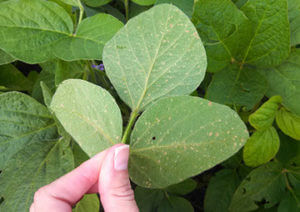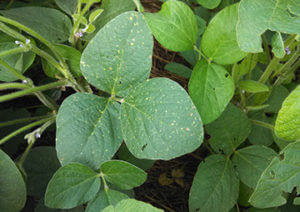Downy mildew is caused by an oomycete (fungus-like organism), Peronospora manshurica which can overwinter in the field in leaf debris and on seed. Pale-green-to-light-yellow spots appear on the upper surfaces of young leaves and enlarge into pale-to-bright-yellow lesions. On the underside of lesions, white to gray tufts of the fungus form (fluffy growth) that are superficial (can be wiped away). Older lesions turn grayish-brown-to-dark brown with yellowish-green margins and may finally become entirely brown and have an appearance similar to other foliar diseases such as Septoria brown spot and soybean rust.
- Downy mildew rarely affects yield and it is not recommended to apply a fungicide for management.
- Resistant cultivars and rotating with a non-host crop for 1 year or more are effective management options when warranted.



